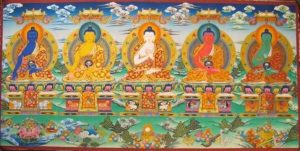
The Buddha described the path to enlightenment very clearly. He explained how the seven factors of enlightenment, when brought to maturity, allow the clear seeing necessary for full awakening. All mental efforts on the path are concerned with one or more of these factors, which are as follows:
1. Mindfulness (sati)
2. Keen investigation of the Dhamma (dhammavicaya)
3. Energy (viriya)
4. Rapture (piti)
5. Calm (passaddhi)
6. Concentration (samadhi)
7. Equanimity (upekkha)
Some people shy away from headings like the Seven Factors of Enlightenment because the word “enlightenment” intimidates them, and in their hearts they inherently fear that they are lacking the skill and confidence needed in their practice regarding each one of these seven factors—to say nothing of all seven. As a result, they flounder in uncertainty, aware within their own minds that they have not established a firm enough base upon which to build an unshakable foundation for practice.
If, however, through the guidance of good teachers and noble friends in the Dhamma, and, most of all, based on their own continuing individual, determined efforts, they can persevere in their quest, they will eventually cultivate the threads of their kammic actions and development, which gradually twist and twine together in a way that the practitioner would never have expected or imagined—eventually becoming a strong cord, which may serve as their safety line on their ascent to the top of the mountain, where the view eventually becomes clear.
The Buddha explains:
Just as in a peaked house, all rafters whatsoever go to a peak, slope to the peak, join in the peak, and of them all is reckoned chief; even so monks, the monk who cultivates and makes much of the seven factors of wisdom, slopes to Nibbana, inclines to Nibbana, tends to Nibbana. (SN 46.7)
If the rafters represent the seven factors, this means that if you practice the factors as best you can, both individually and simultaneously, making your best effort as you go along, there will be growth and development toward higher states of concentration.
Venerable Piyadassi Maha Thera, one of the original founders of the Buddhist Publication Society in Kandy in 1958, in his book on The Seven Factors of Enlightenment (Buddhist Publication Society, Wheel Series 1) has written:
Life, according to the right understanding of a Buddha, is suffering, and that suffering is based on ignorance or avijja. Ignorance is the experience of that which is unworthy of experiencing—namely evil. Further, it is the non-perception of the conglomerate nature of the aggregates; non-perception of sense organ and object in their respective and objective natures; non-perception of the emptiness or the relativity of the elements; non-perception of the dominant nature of the sense controlling faculties; non-perception of the thus-ness—the infallibility—of the four truths, and the five hindrances, because they completely close in, cut off and obstruct. They hinder the understanding of the way to release from suffering. These five hindrances are: sensuality, ill-will, obduracy of mind and mental factors, restlessness and flurry, and doubt.
And what is the nourishment of these hindrances? The three evil modes of life: bodily, vocal, and mental wrong-doing. This three-fold nutriment is in turn nourished by non-restraint of the senses, which is explained by the commentator as the admittance of lust and hate in to the sense-organs of eye, ear, nose, tongue, body, and mind.
The above quotation ties together the things we have said above, albeit in somewhat different words. It all seems to fit together, dependent on right understanding of the word of the Buddha in the Pali texts.
Ven. Piyadassi Maha Thera continues:
The nutriment of non-restraint is shown to be lack of mindfulness and complete awareness. In the context of nutriment, the drifting away of the object (Dhamma)—the lapsing of the mind from the knowledge of the lakkhanas or characteristics of existence (impermanence, voidness and suffering itself), and forgetfulness of the true nature of things—is the reason for non-restraint. It is when one does not bear in mind the transience and the other characteristics of things that one allows oneself all kinds of liberties in speech, in deed, and gives reign to full thought imagery of an unskillful kind. Lack of complete awareness is lack of these four: complete awareness of purpose . . . of suitability . . . of resort . . . and of non-delusion. When one does a thing without right purpose; when one looks at things or does actions that do not help the growth of the good; when one does things inimical to improvement; when one forgets the Dhamma, which is the true resort of one who strives; when one deludedly lays hold of things, believing them to be pleasant, beautiful and substantial—when one behaves thus—then too, non-restraint is nourished.
And below this lack of mindfulness and complete awareness lies unsystematic reflection. . . . The books say this unsystematic reflection is reflection that is off the right course; that is taking the impermanent as permanent, the painful as pleasure, the soulless as soul, the bad as good. The constant rolling on that is samsara, is rooted in unsystematic thinking. When unsystematic thinking increases, it fulfills two things: nescience* and lust for becoming. Ignorance being present, the origination of the entire mass of suffering comes to be. Thus a person who is a shallow thinker, like a ship drifting at the wind’s will, like a herd of cattle swept into the whirlpools of a river, like an ox yoked to a wheel contraption, goes on revolving in the cycle of existence, samsara. (unknowingness)
And it is said that the imperfect confidence . . . in the Buddha, the Dhamma, and the Sangha is the condition that develops unsystematic reflection; and imperfect confidence is due to non-hearing of the True Law, the Dhamma. Finally one does not hear the Dhamma through lack of contact with the wise, through not consorting with the good.
Thus want of kalyanmittata , good friendship appears to be the basic reason for the ills of the world. And conversely the basis and nutriment of all good is shown to be good friendship. That furnishes one with the food of the sublime Dhamma, which in turn produces confidence in the Triple Gem: the Buddha, the Dhamma and the Sangha. When one has confidence in the Triple Gem, there comes into existence profound or systematic thinking, mindfulness, and complete awareness, restraint of the senses, the three good modes of life, the four arousings of mindfulness, the seven factors of enlightenment and deliverance through wisdom, one after another in due order.
Cultivating the Seven Factors of Enlightenment with diligence and energy we can strive to attain enlightenment.
References
Piyadassi Thera. 2008. The Seven Factors of Enlightenment: Satta Bojjhaṅga. Kandy: Buddhist Publication Society BPS Online Edition
Related features from BDG
On the Seven Factors of Enlightenment, Part Two: Mindfulness and Keen Awareness
On the Seven Factors of Enlightenment, Part Three: Arousing Energy and Attaining Rapture
On the Seven Factors of Enlightenment, Part Four: Tranquility, Concentration, and Equanimity












